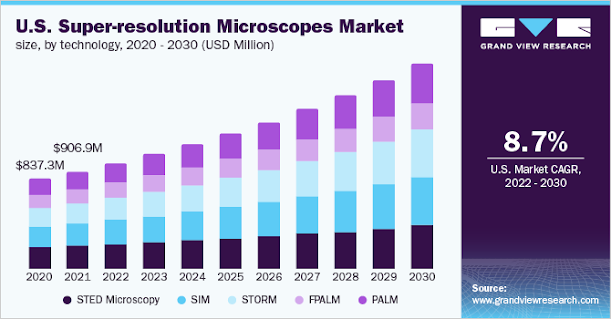The global super-resolution microscopes market size is expected to reach USD 6.6 billion by 2030, according to a new report by Grand View Research, Inc. The market is expected to expand at a CAGR of 9.01% from 2022 to 2030. Increasing application in cell biology and biomedical imaging is a key factor expected to drive the market over the forecast period.
Governments all over the world are supporting R&D for innovative technology, majorly nanotechnology research to help build improved nanoimaging technology-based super-resolution microscopes. The National Institutes of Health in the U.S. established a trans-NH bioengineering nanotechnology program to solicit grant applications for biomedical nanotechnologies. The U.K. government spent EUR 81 million (USD 105 million) on the development of advanced 3D imaging technology in February 2020.
 |
| Super-resolution Microscopes Market |
The COVID-19 pandemic accelerated technological advancement, culminating in the creation of diverse uses for super-resolution microscopes since 2020. Top players have recently introduced new super-resolution microscopes having a variety of applications, including operations, cancer research, COVID-19 investigations, and academic research. For instance, Hitachi High-Tech Corporation introduced the simple-to-use AFM 100 and AFM100 plus Atomic Force Microscopes in July 2021, which provides improved dependability and ease for quality control applications or high-throughput R&D.
Super-resolution Microscopes Market Report Highlights
• In 2021, the life science application segment accounted for the largest revenue share as super-resolution microscopes are used in place of electron microscopes as they allow researchers to image biological specimens more precisely
• Based on technology, STED microscopy held the largest revenue share in 2021 due to its ability to deliver diffraction-unlimited images, with no need for further computational processing
• The nanotechnology application segment is projected to register the fastest CAGR during the forecast period. This can be attributed to key players launching new products based on nanotechnology. For instance, in October 2020, Bruker Corporation released Vutara VXL, its super-resolution microscope, which is a biological workstation for research on proteins, DNA, RNA, and other biomolecules for nanoscale imaging
• North America held the largest revenue share in 2021. Increasing research activities in different segments of life science and nanotechnology and initiatives taken by the government in past years, where research funding agencies encouraged researchers to adopt super-resolution microscopes, are expected to drive the regional market
• Asia Pacific is expected to expand at the fastest CAGR over the forecast period. High product sales in countries like China and the growing interest of photonics companies and venture capitalists in the field of electronics and life sciences are the factors driving the regional market
• The market is technology-driven and therefore, manufacturers engage in rigorous R&D to develop new and advanced products, which cater to the changing needs of healthcare and other industries
The global life science microscopes industry generated over USD 3.36 billion in 2021 and is expected to grow at a CAGR of 8.9% over the forecast period.
Super-resolution Microscopes Market Segmentation
Grand View Research has segmented the global super-resolution microscopes market on the basis of technology, application, and region:
Super-resolution Microscopes Technology Outlook (Revenue, USD Million, 2017 - 2030)
• Stimulated Emission Depletion (STED) Microscopy
• Structured-Illumination Microscopy (SIM)
• Stochastic Optical Reconstruction Microscopy (STORM)
• Fluorescence Photoactivated Localization Microscopy (FPALM)
• Photoactivated Localization Microscopy (PALM)
Super-resolution Microscopes Application Outlook (Revenue, USD Million, 2017 - 2030)
• Nanotechnology
• Life Science
• Material Science
• Semi-conductor
• Other Applications
Super-resolution Microscopes Regional Outlook (Revenue, USD Million, 2017 - 2030)
• North America
- U.S.
- Canada
• Europe
- U.K.
- Germany
- France
- Italy
- Spain
• Asia Pacific
- China
- Japan
• Latin America
- Brazil
- Mexico
• Middle East & Africa (MEA)
- South Africa
List of Key Players in Super-resolution Microscopes Market
• ZEISS
• Applied Precision (GE Healthcare)
• Nikon Corporation
• Olympus Corporation
• Leica Microsystems (Danaher Corporation)
• Bruker Corporation
• Hitachi High Technologies
Request free sample copy of Life Science Microscopes Industry Data Book @ https://www.grandviewresearch.com/sector-report/life-science-microscopes-industry-data-book/request/rs1






